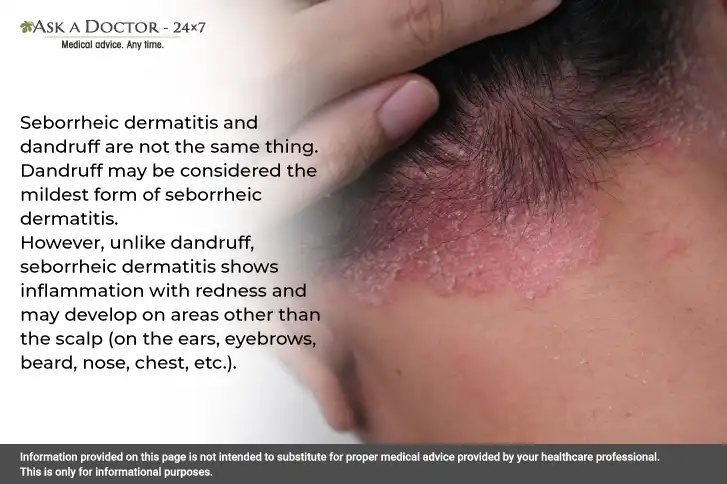Know About Seborrheic Dermatitis: That Itchy, Flaky Skin Condition
The term "seborrheic" refers to the "sebaceous" gland while “derm” means “skin.” Seborrheic dermatitis occurs when the sebaceous (oil-producing) glands of the skin become overactive, causing an inflammatory reaction. Seborrheic dermatitis is a common skin ailment that causes an itchy, scaly rash on oily areas of the skin (face, nose). It can appear as white or yellow color, crusty or powdery flakes on your scalp or beard. It is non-contagious.
Although seborrheic dermatitis is often mistaken for eczema, psoriasis, or an allergic reaction, it is primarily caused by a confluence of genetic factors, fungal development, and the skin's reaction to excess oil. This blog examines the causes, symptoms, and successful management of seborrheic dermatitis. Read on...
Symptoms of Seborrheic Dermatitis

The symptoms of seborrheic dermatitis can vary from person to person. It can mimic those of other skin disorders. The symptoms include the following:
- Itching in the scalp
- Scales on the scalp that are dry or oily
- Redness on the scalp, face, or other affected areas
- A red or yellow scaly rash along the hairline, the ear canal, the back of the ears, on the eyebrows, around the nose, the folds of the arms, legs, or groin, and/or on the chest
- Red, swollen, and flaky eyelids (blepharitis)
- Crusty yellow scales on the head of infants (cradle cap)
For a proper diagnosis, always consult your healthcare provider.
Who Gets Seborrheic Dermatitis?
This common skin condition can develop in people of all ages and races. While it can appear at any time, it’s most likely to begin during one of these stages of life:
- Infancy: It can be seen in children 2 to 12 months of age. Because of its distinctively scaly scalp, the condition is often known as cradle cap in neonates. But the cradle cap can also appear in the diaper area, folds of their skin, back, and chest. In this age group, seborrheic dermatitis typically goes away on its own in the first year.
- Middle age: At this age, seborrheic dermatitis typically manifests as dandruff. The condition is usually intermittent.
- Old age: Seborrheic dermatitis is typically more sporadic when it occurs at this age; however, after the age of sixty it becomes less prevalent.
Causes of Seborrheic Dermatitis
Seborrheic dermatitis is caused by a combination of genetic and environmental factors. However, certain medical conditions like psoriasis, HIV, acne, rosacea, Parkinson's disease, epilepsy, alcoholism, depression, eating disorders, and the healing process following a heart attack or stroke can raise a person's chance of getting seborrheic dermatitis.
The following are typical causes of seborrheic dermatitis:
- Family history
- Excess oil production
- Overgrowth of Malassezia yeast, which is naturally present on the skin, can overgrow and trigger an inflammatory response
- Prolonged stress
- Weakened immune system like organ transplant recipients
- Contact with chemicals like strong detergents, solvents, and soap
- Recovery following a traumatic life event, such as a heart attack or the death of a loved one
- Ongoing illness or hormonal changes
- Weather changes like a shift in the season, cold, or dry weather
- Certain drugs, such as lithium, psoralen, and interferon
- Medical conditions like Parkinson's disease and HIV
Management of Seborrheic Dermatitis
While seborrheic dermatitis is a chronic condition, it can often be managed with various treatments, including:
- Medicated shampoos: Prescription or over-the-counter shampoos with active components including ketoconazole, selenium sulfide, or coal tar can help control scalp symptoms.
- Topical ointments and creams: For more severe cases or when other parts of the body are impacted, prescription-strength topical therapies with corticosteroids or antifungal drugs could be advised.
- Antifungal drugs: Oral antifungal drugs may be recommended when yeast overgrowth is a major contributing cause.
- Lifestyle changes: Symptoms can be managed by avoiding triggers like high levels of stress, harsh skincare products, and severe weather conditions.
Conclusion
We have learned so far that seborrheic dermatitis is a common, non-contagious skin condition that appears as red, dry, flaky, itchy skin on the scalp and other parts of the body. Its presence doesn’t mean the skin is unclean or infected. Medications manage the symptoms. There's no reason to worry if you have seborrheic dermatitis. It’s essential to consult a dermatologist for a proper diagnosis and personalized treatment plan if you suspect you have seborrheic dermatitis. While the condition is not curable, it can usually be effectively controlled with appropriate care and treatment.
If you have any questions related to seborrheic dermatitis, you can Ask a Dermatologist at Ask a Doctor, 24x7.
Recently Answered Questions Related to Seborrheic Dermatitis
- Suggest Medication For Seborrhoeic Dermatitis
- Suggest Treatment For Seborrheic Dermatitis
- What Causes Dry Scalp After Using Nizoral?
- Suggest Treatment For Itching And Burning Sensation On Scalp
- Suggest Treatment For Seborrheic Dermatitis On Penis
- Suggest Treatment For Seborrheic Dermatitis And Hair Loss
- Having Seborrheic Dermatitis. Suggested Sebowash. Can Other Shampoo Be Used, Does This Cause Hair Fall?
- What Causes Seborrheic Dermatitis?
Disclaimer: Information provided on this page is not intended to substitute for proper medical advice provided by your healthcare professional. This is only for informational purposes.
Ask a Specialist
Recent Questions


